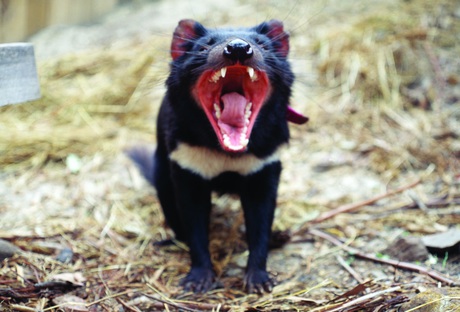Devils could be evolving resistance to DFTD

Twenty years after the first case of devil facial tumour disease (DFTD) emerged, causing populations of Tasmanian devils to decline by at least 80%, the animals appear to be fighting back.
The infectious and fatal cancer has been decimating wild Tasmanian devils since 1996, killing most devils at sexual maturity. Yet devils still persist in places where DFTD originally appeared, despite models predicting that they should now be extinct. This has led researchers to believe that the carnivorous marsupials are swiftly evolving to resist the disease.
“Models I published seven years ago predicted that these populations should now be extinct,” said Professor Hamish McCallum from Griffith University. “I am very glad that I was wrong — it appears that the devils are saving themselves through evolution.”
Professor McCallum partnered with Menna Jones from the University of Tasmania, Andrew Storfer from Washington State University and Paul Hohenlohe from the University of Idaho to compare the frequency of genes in specific regions of pre-disease DNA samples to the frequency of genes in corresponding regions of DNA samples collected 8–16 years following DFTD emergence at three independent sites across Tasmania. Their study has been published in the journal Nature Communications.
The scientists identified two small genomic regions in the DNA samples from all three sites that have changed significantly in response to the strong selection imposed by the disease. Five of seven genes in the two regions were related to cancer or immune function in other mammals, suggesting that Tasmanian devils are evolving resistance to DFTD. The rapid evolution occurred in as little as 4–8 generations of devils since the disease outbreak.
“The results are surprising because rapid evolution requires pre-existing genetic variation and Tasmanian devils have low levels of genetic diversity,” said Professor McCallum.
The researchers currently are in the process of determining the specific functionality of the genomic regions identified in the study. They are hopeful that devils with the apparently DFTD-resistant DNA can be bred to enhance the genetic diversity of an off-island captive insurance population in case devil reintroductions are needed in the future.
Professor McCallum stressed that, while the devils may be able to save themselves through evolution, it is essential to develop management strategies that assist them to do so. This is particularly vital given that DFTD is one of only two cancers in vertebrae that are transmissible.
“They spread not just within their host but to other animals, effectively becoming immortal,” Professor McCallum said. “DFTD presents a unique research opportunity to study the early stages of the evolution of a new disease and transmissible cancer with its animal host.
“This is a bizarre cancer in a unique Australian marsupial, but the disease and the way that the Tasmanian devils respond can provide new general insights into cancer biology.”
'Low-risk' antibiotic linked to rise of dangerous superbug
A new study has challenged the long-held belief that rifaximin — commonly prescribed to...
Robotic hand helps cultivate baby corals for reef restoration
The soft robotic hand could revolutionise the delicate, labour-intensive process of cultivating...
Stem cell experiments conducted in space
Scientists are one step closer to manufacturing stem cells in space — which could speed up...




